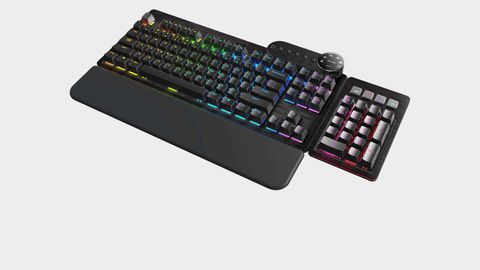Our Verdict
A great physical keyboard, with a huge amount of customisation available to it. But it can also be a fantastic base from which to almost build your own personally tailored TKL gaming board if you go barebones.
For
- Great hardware
- Impressive modularity
- Looks great
Against
- Base camp software is still immature
PC Gamer's got your back
Answer me this: why the hell has everyone been sticking the numpad on the right-hand side of their gaming keyboards? The new Mountain Everest Max gaming keyboard means I can instead jam it onto the left-hand side, and that makes a whole lot more sense to me. It gives me all the benefits of a TKL keyboard design, but with the utility of a full-size board. And that also means this is now my new favourite slab. Especially in its fresh hot-pink trim. Gotta love those RGB LEDs.
You probably haven't heard of Mountain, a fresh-faced upstart in the cutthroat world of PC peripherals. After all, it's maybe not the most memorable of names for a keyboard and mouse manufacturer, but then it doesn't also have the offensive overtones of other PC gaming race-related nomenclatures.
That comparison is important though, because the Mountain Everest is a gaming keyboard aiming to take on the big boys, and most especially at the enthusiast-level in which Glorious has been making a name for itself. Crafting completely modular gaming keyboards, which can house any hot-swappable mechanical switches you can buy, is something Glorious has been doing for years, bringing once-niche custom keyboard fun into the mainstream.
The Mountain Everest, especially in this Everest Max trim, is all about that completely modular experience, giving you everything you need to tailor your device to exactly how you want to use it. And it's not just some keyboard that's been picked out of the bin of some peripheral factory in China and had a logo embossed on it. The Everest has a whole host of new design elements and features you won't find in any other board.
Switches - Cherry MX hot-swappable
Layout - ANSI / ISO
Backlight - RGB
Rollover - N-key
Polling rate - 1,000Hz
Keycaps - ABS
Connection - Wired USB Type-C
Discrete media controls - Yes
It's also a far more modular affair than simply being a case of mix-and-match mechanical switches. The base keyboard features two plates of milled aluminum, forming an incredibly solid frame, with the all-important all-round RGB LED strip in between them. That base board can be picked up as a pure, small form factor TKL barebones unit, without switches, if you want to create your own gaming keyboard from scratch.
The whole package though feels super high-end, which it ought to because the full Mountain Everest Max kit weighs in at $270 (£230), while the barebone base is $130 (£130) on its own. The Everest Max comes with all the trimmings including a bunch of different Cherry MX hot-swappable switches for you to play with and see the difference. My full board is replete with linear red switches, though there are blue, brown, silent red, and silver Cherry MX versions available. Though I might drop some clicky blues into the numpad for kicks. Mountain also sells whole extra packs of Cherry MX and Kailh switches on the accessories side of its site.
That TKL base unit is excellent. As I mentioned it's incredibly solid, but also comes with a USB 3.2 Gen1 hub on the rear, cable routing for its Type-C connection on the underside (and through the palm rest), and a set of magnetic feet you can build up to give you an angle to type on. That, I was not expecting to like.
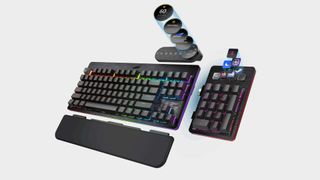
A pet peeve with gaming keyboards is when I shift them around my desktop and the feet fold under. Logitech's feet that fold out and not back help, but I figured magnetic feet you build up in stages would definitely collapse under scrutiny. (But damn, those magnets are strong.)
And then, with the Everest Max, you also get a squishy magnetically attached palm rest, a media dock with a customisable IPS display and discrete media keys. It feels like a direct homage to Logitech's mighty G15 keyboard. That was an enthusiast board from back in the day, which hasn't been repeated recently. It was one that also became a darling of the modding crowd, who created app after app to use on its monotone pixelated display.
The Everest version comes with a shiny digital display and a host of built-in apps—such as listing component performance, time and date, stop-watch, lighting, brightness, and volume—though Mountain has said there are no plans yet to release an SDK to allow users to create their own bespoke apps for the module.
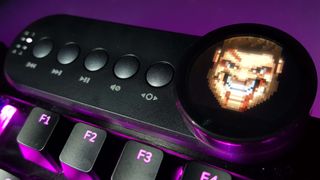
And if the tenkeyless design isn't doing it for you there's that magnetically attached numpad too. Mountain has provided the option to have the numpad and media dock plugged into the base in a couple of different configurations, which is how I came to discover the joy of a left-hand numpad.
I don't always need to have access to a numpad, but it can be handy when filling in benchmark spreadsheets and the like, but having to use my mouse hand to hit the numbers does not an efficient workflow make. The southpaw numpad also means I can have my mouse hand a lot closer to my WSAD hand when I'm gaming too, which puts less strain on my back and shoulders and is ergonomically more preferable. That's why a lot of pros will stick with TKL designs for life, yo.
And if you don't need the numpad you can just detach it and shift it out of the way and you're back to a fully TKL setup, giving you a little more space on your desktop. The modular connection is something Mountain has spent a lot of time working on, from the extra movement in the USB Type-C connection to allow for inevitable flex, to the strength of the magnets.


And that attention to detail shows. It hooks into place solidly, powers up reliably, and is simple to remove. And it barely shifts when you're moving the keyboard as a whole around your desk. Like the switches, it's hot-swappable, so you can plug and unplug the numpad on the fly as and when you need it. The unit itself also comes with four customisable keys, with digital displays under each flat, see-through keycap. These can be program launchers, macros, or pretty much anything the Base Camp software allows.
Ah, Base Camp. While I was immediately impressed with the actual hardware Mountain provides, the software has not felt anywhere near as robust. Which, honestly, is not a surprise. That's not to denigrate Mountain's devs in any way, but it's the new kid on the block and creating software from scratch, for a whole new keyboard, is not easy. And it showed in the first iteration of the software I used with the Everest Max. It killed my board. Completely. No longer was it a gaming slab but a gaming brick.
So I was nervous testing the second review unit the company sent our way, and had to purge the original software from my system manually to remove any last vestiges of its existence before installing the updated Base Camp app.
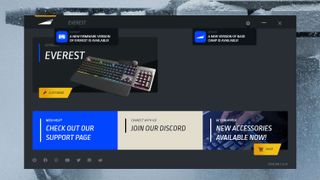
Which is far more sturdy. I've had not a single issue with the Everest software since, not in use anyway, and I've been messing around with it a whole lot, from adding in new images and program-launching buttons, to customising the media dock with my own gurning DOOM face. But that said, updating the app and the Everest's firmware fills me with dread. The last Base Camp update failed for no given reason, and the latest firmware update has been sat at 100 percent for the past two hours.
That's a frustration, but also something that, given time and dev resources, can actually be fixed. Ergonomic or build quality issues with the hardware cannot. And I have no reservations about that side of the Mountain.
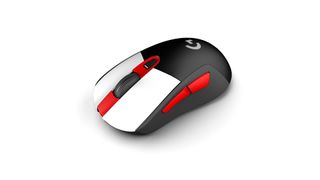
Best gaming mouse: the top rodents for gaming
Best gaming keyboard: your PC's best friend...
Best gaming headset: don't ignore in-game audio
I've reviewed a whole lot of keyboards in my time as a tech journo, and I always know when I've found a good one because it doesn't get unplugged the instant I hit publish on the review and dropped atop the heap of discarded peripherals that now fills my house.
And the Mountain Everest Max is going to remain on my desktop for the foreseeable future. I'm probably going to play around with the keycaps (G.Skill's recent Crystal Crown pudding caps have a strange draw to me) and I might even hook out the switches in the Logitech G Pro TKL keyboard my 16 month-old son uses to emulate his dear ol' dad.
Sure, modular keyboards are nothing new; Logitech's been in the game recently with hot-swappable switches, and Glorious' GMMK has been a quality option for years. Indeed removable numpads aren't either, though none have been able to be solid enough to look and function well on a high-end board. But, high pricing aside, the Everest Max has the edge on all of them for me, and is going to be my keyboard of choice from here on.
A great physical keyboard, with a huge amount of customisation available to it. But it can also be a fantastic base from which to almost build your own personally tailored TKL gaming board if you go barebones.

Dave has been gaming since the days of Zaxxon and Lady Bug on the Colecovision, and code books for the Commodore Vic 20 (Death Race 2000!). He built his first gaming PC at the tender age of 16, and finally finished bug-fixing the Cyrix-based system around a year later. When he dropped it out of the window. He first started writing for Official PlayStation Magazine and Xbox World many decades ago, then moved onto PC Format full-time, then PC Gamer, TechRadar, and T3 among others. Now he's back, writing about the nightmarish graphics card market, CPUs with more cores than sense, gaming laptops hotter than the sun, and SSDs more capacious than a Cybertruck.
